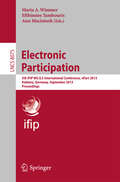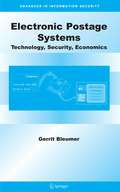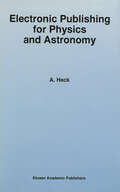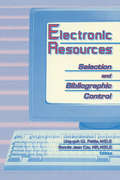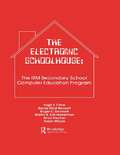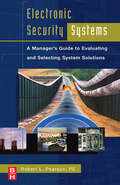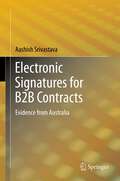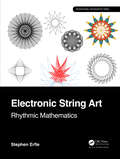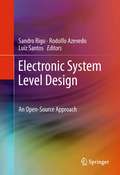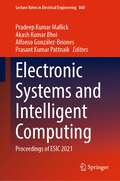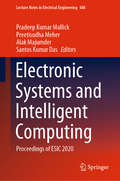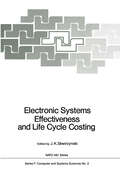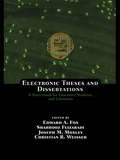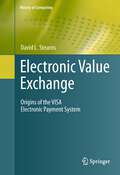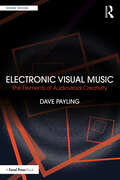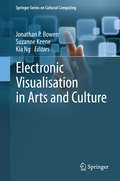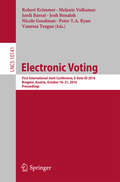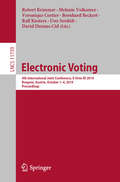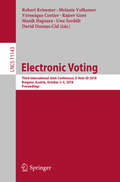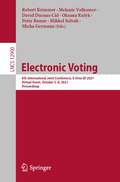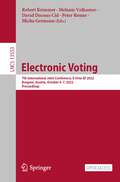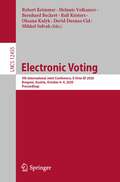- Table View
- List View
Electronic Participation: 5th IFIP WG 8.5 International Conference, ePart 2013, Koblenz, Germany, September 17-19, 2013, Proceedings (Lecture Notes in Computer Science #8075)
by Maria A. Wimmer Efthimios Tambouris Ann MacintoshThis book constitutes the refereed proceedings of the 5th IFIP WG 8.5 International Conference on Electronic Participation, ePart 2013, held in Koblenz, Germany, in September 2013. The 13 revised full papers presented were carefully reviewed and selected from 30 submissions. The papers cover a wide range of research in both social and technological scientific domains, seeking to demonstrate new theories, concepts, methods and styles of eParticipation with the support of innovative ICT. They have been organized in the following topical sections: research directions, social media and eParticipation, and online deliberation.
Electronic Postage Systems: Technology, Security, Economics (Advances in Information Security #26)
by Gerrit BleumerThis book offers the first comprehensive overview of contemporary systems for secure electronic/digital postage. It introduces a taxonomy of electronic postage systems and explains their security risks and countermeasures. The underlying cryptographic mechanisms are introduced and explained, and the industrial-scale electronic postage systems existing worldwide are sorted out with respect to this taxonomy. The author also discusses privacy and anonymous mail, the state of standardization of electronic postage, and the process of security evaluation and testing of electronic postage systems.
Electronic Publishing for Physics and Astronomy (Astrophysics and Space Science Library #224)
by Andre HeckThe ship has left the Miraflores Locks, let loose from the 'mules' run by the crews of the Panama Canal Commission. She has picked up speed while passing under the Bridge of the Americas which links de facto the Northern and Southern parts of the continent, and has headed resolutely towards the Pacific Ocean waters along the rows of boats of all kinds waiting to cross the Canal in the other direction. Through a layer of tropical clouds, the setting Sun is bleakly illuminating the tall white highrises of Panama City on the port side. It took a full day to cautiously move through the whole system of locks and cuts. Back in the stateroom, I open again a working copy of this book and type down this foreword on the pocket computer. The last chapter was received the day before while speeding through the Caribbean Sea and my main work as Editor is now over. It has been a real pleasure and a great honour to be given the oppor tunity of compiling this book and interacting with the various contributors through the latest technologies while being sometimes in geographically very different places. The quality of the authors, the scope of experiences they cover, the messages they convey make of this book a unique and timely publication. The reader will certainly enjoy as much as I did going through such a variety of well-inspired chapters from so many different horizons.
Electronic Resources: Selection and Bibliographic Control
by Ling Yuh W Pattie Bonnie J CoxThe universe of electronic resources is indeed diverse, expansive, intimidating, and unstructured compared to the finite, prepackaged print world upon which the information delivery infrastructure has been constructed. Electronic Resources: Selection and Bibliographic Control addresses the resultant concerns of information professionals as they struggle to define, select, and control electronic resources in libraries and information centers today. This book offers readers an overview of issues and provides a common ground for deliberations and decisionmaking. Librarians and students concerned with the Internet and related issues will appreciate the broad scope and in-depth discussions in Electronic Resources: Selection and Bibliographic Control. From both conceptual and pragmatic standpoints, this book enlightens the reader on such topics as:Internet resourcesthe relationship between OPAC and InternetStandard Generalized Markup Language (SGML) versus USMARCText Encoding Initiative (TEI)Core Language and the Information BusDublin Core Metadata as a discovery/retrieval tooldecision-making matrix modele-texts and e-thesesdigital materials and digital librariesThis book also gives the reader an inside look at a number of specific emerging projects from around the world. Highlighted here are the CATRIONA project from the U.K.--designing an Internet discovery and retrieval system; the ALCUIN project--using traditional infrastructure to handle Internet resources; the Center for Electronic Texts in the Humanities (CETH) and the Electronic Text Center at the University of Virginia; the OCLC Internet Cataloging project; and the National Digital Library Program (NDLP), Encoded Archival Description (EAD), and electronic CIP projects at the Library of Congress.Electronic Resources: Selection and Bibliographic Control clearly illustrates the evolving role of librarian fro
Electronic Resources: Selection and Bibliographic Control
by Ling Yuh W Pattie Bonnie J CoxThe universe of electronic resources is indeed diverse, expansive, intimidating, and unstructured compared to the finite, prepackaged print world upon which the information delivery infrastructure has been constructed. Electronic Resources: Selection and Bibliographic Control addresses the resultant concerns of information professionals as they struggle to define, select, and control electronic resources in libraries and information centers today. This book offers readers an overview of issues and provides a common ground for deliberations and decisionmaking. Librarians and students concerned with the Internet and related issues will appreciate the broad scope and in-depth discussions in Electronic Resources: Selection and Bibliographic Control. From both conceptual and pragmatic standpoints, this book enlightens the reader on such topics as:Internet resourcesthe relationship between OPAC and InternetStandard Generalized Markup Language (SGML) versus USMARCText Encoding Initiative (TEI)Core Language and the Information BusDublin Core Metadata as a discovery/retrieval tooldecision-making matrix modele-texts and e-thesesdigital materials and digital librariesThis book also gives the reader an inside look at a number of specific emerging projects from around the world. Highlighted here are the CATRIONA project from the U.K.--designing an Internet discovery and retrieval system; the ALCUIN project--using traditional infrastructure to handle Internet resources; the Center for Electronic Texts in the Humanities (CETH) and the Electronic Text Center at the University of Virginia; the OCLC Internet Cataloging project; and the National Digital Library Program (NDLP), Encoded Archival Description (EAD), and electronic CIP projects at the Library of Congress.Electronic Resources: Selection and Bibliographic Control clearly illustrates the evolving role of librarian fro
The Electronic Schoolhouse: The Ibm Secondary School Computer Education Program
by H. Cline R. E. Bennett R. C. Kershaw B. StecherPublished in the year 1985, The Electronic Schoolhouse is a valuable contribution to the field of Education.
The Electronic Schoolhouse: The Ibm Secondary School Computer Education Program
by Hugh F. Cline, Randy Elliot Bennett, Roger C. Kershaw, Martin B. Schneiderman, Brian Stecher and Susan WilsonPublished in the year 1985, The Electronic Schoolhouse is a valuable contribution to the field of Education.
Electronic Security Systems: A Manager's Guide to Evaluating and Selecting System Solutions
by Robert PearsonElectronic Security Systems is a book written to help the security professional understand the various electronic security functional components and the ways these components interconnect. Providing a holistic approach to solving security issues, this book discusses such topics as integrating electronic functions, developing a system, component philosophy, possible long-term issues, and the culture within a corporation. The book uses a corporate environment as its example; however, the basic issues can be applied to virtually any environment.For a security professional to be effective, he or she needs to understand the electronics as they are integrated into a total security system. Electronic Security Systems allows the professional to do just that, and is an invaluable addition to any security library.* Provides a well-written and concise overview of electronic security systems and their functions* Takes a holistic approach by focusing on the integration of different aspects of electronic security systems* Includes a collection of practical experiences, solutions, and an approach to solving technical problems
Electronic Signatures for B2B Contracts: Evidence from Australia
by Aashish SrivastavaThe last few centuries have seen paper-based documents and manuscript signatures dominate the way businesses enter into a contractual relationship with each other. With the advent of Internet, replacing paper-based contracts with B2B electronic contracts is a possibility. However, an appropriate technology and an enabling legislation are crucial for this change to happen. On the technology front this feature has the potential to enable business executives to sit in front of their computer and sign multi-million dollar deals by using their electronic signatures. On the legal front various pieces of legislation have been enacted and policies developed at both national and international levels to give legal recognition to such type of contracts. This book presents the findings of an empirical study on large public listed Australian companies that examined businesses’ perception towards the use of electronic signatures in B2B contracts. Essentially, it identifies six key factors that create a disincentive to businesses to move from the practice of paper- based signatures to the new technology of electronic signatures. This book offers legal practitioners, academics and businesses insights into issues associated with the use of electronic signatures and suggests a number of measures to promote its usage in B2B contracts.
Electronic String Art: Rhythmic Mathematics (AK Peters/CRC Recreational Mathematics Series)
by Stephen ErfleString art is a well-known and popular activity that uses string, a board, and nails to produce artistic images (although there are variations that use different modalities). This activity is beloved because simple counting rules are used to create beautiful images that can both adorn walls and excite young minds. The downside of this highly tactile activity is that it is quite time-consuming and rigid. By contrast, electronic string art offers much more flexibility to set up or change nail locations and counting rules, and the images created from those changes change instantaneously.Electronic String Art: Rhythmic Mathematics invites readers to use the author’s digital resources available on the ESA website to play with the parameters inherent in string art models while offering concise, accessible explanations of the underlying mathematical principles regarding how the images were created and how they change. Readers will have the opportunity to create visually beautiful works of art while learning concepts from geometry, number theory, and modular arithmetic from approximately 200 short-interdependent sections.Features Readers are able to drill-down on images in order to understand why they work using short (1 to 2 page) stand-alone sections Sections are lessons that were created so that they could be digested in a single sitting These sections are stand-alone in the sense that they need not be read sequentially but can be referred to based on images that the reader finds interesting An open-ended, inherently flexible teaching resource for elementary, middle, and high school-level mathematics The most mathematically challenging sections (or portions of a section) are designated MA and may not be accessible to elementary and middle school readers Will be appreciated by anyone interested in recreational mathematics or mathematical artworks even if the users are not interested in the underlying mathematics Includes exercises, solutions, and many online digital resources These QR codes take you to these digital resources. One takes you directly to the web version of the string art model (used as a starting point for teaching the parameters of the model in Section 25.5). The other takes you to the ESA web page with additional links to a variety of resources.
Electronic System Level Design: An Open-Source Approach
by Sandro Rigo, Rodolfo Azevedo and Luiz SantosElectronic System Level Design: an Open-Source Approach is based on the successful experience acquired with the conception of the ADL ArchC, the development of its underlying tool suite, and the building of its platform modeling infrastructure. With more than 10000 accesses per year since 2004, the dissemination of ArchC models reached not only students in quest of proper infrastructure to develop their research projects but also some companies in need of processor models to build virtual platforms using SystemC. The need to anticipate the development of hardware-dependent software and to build virtual prototypes gave rise to Transaction Level Modeling (TLM). Since SystemC provided the elements and the adequate abstraction level for supporting TLM, their relation has grown so strong that OSCI created a TLM Working Group whose effort resulted in the recently released TLM 2.0 standard, which is also covered in this book.
Electronic Systems and Intelligent Computing: Proceedings of ESIC 2021 (Lecture Notes in Electrical Engineering #860)
by Pradeep Kumar Mallick Akash Kumar Bhoi Alfonso González-Briones Prasant Kumar PattnaikThis book is a compilation of contributed research work from International Conference on Electronic Systems and Intelligent Computing (ESIC 2021) and covers the areas of electronics, communication, electrical and computing. This book is specifically targeted to the students, research scholars and academician from the background of electronics, communication, electrical and computer science. Advances in electronics, communication, electrical and computing cover the different approaches and techniques for specific applications using particle swarm optimization, Otsu’s function and harmony search optimization algorithm, DNA-NAND gate, triple gate SOI MOSFET, micro-Raman and FTIR analysis, high-k dielectric gate oxide, spectrum sensing in cognitive radio, microstrip antenna, GPR with conducting surfaces, energy-efficient packet routing, iBGP route reflectors, circularly polarized antenna, double fork-shaped patch radiator, implementation of Doppler radar at 24 GHz, iris image classification using SVM, digital image forgery detection, secure communication, spoken dialog system and DFT-DCT spreading strategies.
Electronic Systems and Intelligent Computing: Proceedings of ESIC 2020 (Lecture Notes in Electrical Engineering #686)
by Pradeep Kumar Mallick Preetisudha Meher Alak Majumder Santos Kumar DasThis book presents selected, high-quality research papers from the International Conference on Electronic Systems and Intelligent Computing (ESIC 2020), held at NIT Yupia, Arunachal Pradesh, India, on 2 – 4 March 2020. Discussing the latest challenges and solutions in the field of smart computing, cyber-physical systems and intelligent technologies, it includes papers based on original theoretical, practical and experimental simulations, developments, applications, measurements, and testing. The applications and solutions featured provide valuable reference material for future product development.
Electronic Systems Effectiveness and Life Cycle Costing (NATO ASI Subseries F: #3)
by J. K. SkwirzynskiThis volume contains the complete proceedings of a NATO Advanced Study Institute on various aspects of the reliability of electronic and other systems. The aim of the Insti~ute was to bring together specialists in this subject. An important outcome of this Conference, as many of the delegates have pointed out to me, was complementing theoretical concepts and practical applications in both software and hardware. The reader will find papers on the mathematical background, on reliability problems in establishments where system failure may be hazardous, on reliability assessment in mechanical systems, and also on life cycle cost models and spares allocation. The proceedings contain the texts of all the lectures delivered and also verbatim accounts of panel discussions on subjects chosen from a wide range of important issues. In this introduction I will give a short account of each contribution, stressing what I feel are the most interesting topics introduced by a lecturer or a panel member. To visualise better the extent and structure. of the Institute, I present a tree-like diagram showing the subjects which my co-directors and I would have wished to include in our deliberations (Figures 1 and 2). The names of our lecturers appear underlined under suitable headings. It can be seen that we have managed to cover most of the issues which seemed important to us. VI SYSTEM EFFECTIVENESS _---~-I~--_- Performance Safety Reliability ~intenance ~istic Lethality Hazards Support S.N.R. JARDINE Max. Vel. etc.
Electronic Theses and Dissertations: A Sourcebook for Educators: Students, and Librarians (Books In Library And Information Science Ser. #Vol. 65)
by Edward A.Fox Shahrooz Feizabadi Joseph M. Moxley Christian R. WeisserElectronic Theses and Dissertations examines how electronic publication of theses and dissertations might enhance graduate education. This text clarifies the composition, evaluation, dissemination, and preservation of electronic theses and dissertations (ETDs), and provides a conceptual framework for the development of effective ETD programs. It id
Electronic Value Exchange: Origins of the VISA Electronic Payment System (History of Computing)
by David L. StearnsElectronic Value Exchange examines in detail the transformation of the VISA electronic payment system from a collection of non-integrated, localized, paper-based bank credit card programs into the cooperative, global, electronic value exchange network it is today. Topics and features: provides a history of the VISA system from the mid-1960s to the early 1980s; presents a historical narrative based on research gathered from personal documents and interviews with key actors; investigates, for the first time, both the technological and social infrastructures necessary for the VISA system to operate; supplies a detailed case study, highlighting the mutual shaping of technology and social relations, and the influence that earlier information processing practices have on the way firms adopt computers and telecommunications; examines how “gateways” in transactional networks can reinforce or undermine established social boundaries, and reviews the establishment of trust in new payment devices.
Electronic Visual Music: The Elements of Audiovisual Creativity (Sound Design)
by Dave PaylingElectronic Visual Music is a comprehensive guide to the composition and performance of visual music, and an essential text for those wanting to explore the history, current practice, performance strategies, compositional methodologies and practical techniques for conceiving and creating electronic visual music. Beginning with historical perspectives to inspire the reader to work creatively and develop their own individual style, visual music theory is then discussed in an accessible form, providing a series of strategies for implementing ideas. Including interviews with current practitioners, Electronic Visual Music provides insight into contemporary working methods and gives a snapshot of the state of the art in this ever-evolving creative discipline. This book is a valuable resource for artists and practitioners, as well as students, educators and researchers working in disciplines such as music composition, music production, video arts, animation and related media arts, who are interested in informing their own work and learning new strategies and techniques for exploration and creative expression of electronic visual music.
Electronic Visual Music: The Elements of Audiovisual Creativity (Sound Design)
by Dave PaylingElectronic Visual Music is a comprehensive guide to the composition and performance of visual music, and an essential text for those wanting to explore the history, current practice, performance strategies, compositional methodologies and practical techniques for conceiving and creating electronic visual music. Beginning with historical perspectives to inspire the reader to work creatively and develop their own individual style, visual music theory is then discussed in an accessible form, providing a series of strategies for implementing ideas. Including interviews with current practitioners, Electronic Visual Music provides insight into contemporary working methods and gives a snapshot of the state of the art in this ever-evolving creative discipline. This book is a valuable resource for artists and practitioners, as well as students, educators and researchers working in disciplines such as music composition, music production, video arts, animation and related media arts, who are interested in informing their own work and learning new strategies and techniques for exploration and creative expression of electronic visual music.
Electronic Visualisation in Arts and Culture (Springer Series on Cultural Computing)
by Jonathan P. Bowen, Suzanne Keene and Kia NgPresenting the latest technological developments in arts and culture, this volume demonstrates the advantages of a union between art and science. Electronic Visualisation in Arts and Culture is presented in five parts:Imaging and CultureNew Art PracticeSeeing MotionInteraction and Interfaces Visualising HeritageElectronic Visualisation in Arts and Culture explores a variety of new theory and technologies, including devices and techniques for motion capture for music and performance, advanced photographic techniques, computer generated images derived from different sources, game engine software, airflow to capture the motions of bird flight and low-altitude imagery from airborne devices.The international authors of this book are practising experts from universities, art practices and organisations, research centres and independent research. They describe electronic visualisation used for such diverse aspects of culture as airborne imagery, computer generated art based on the autoimmune system, motion capture for music and for sign language, the visualisation of time and the long term preservation of these materials. Selected from the EVA London conferences from 2009-2012, held in association with the Computer Arts Society of the British Computer Society, the authors have reviewed, extended and fully updated their work for this state-of-the-art volume.
Electronic Voting: First International Joint Conference, E-Vote-ID 2016, Bregenz, Austria, October 18-21, 2016, Proceedings (Lecture Notes in Computer Science #10141)
by Robert Krimmer Melanie Volkamer Jordi Barrat Josh Benaloh Nicole Goodman Peter Y. Ryan Vanessa TeagueThis book constitutes the thoroughly refereed conference proceedings of the First International Joint Conference on Electronic Voting, E-Vote-ID 2016, held in Bregenz, Austria, in October 2016. The 14 full papers presented were carefully reviewed and selected from 57 submissions. They represent a wide range of technological proposals for different voting settings (be it in polling stations, remote voting or even mobile voting) and case studies from different countries already using electronic voting or having conducted first trial elections.
Electronic Voting: 4th International Joint Conference, E-Vote-ID 2019, Bregenz, Austria, October 1–4, 2019, Proceedings (Lecture Notes in Computer Science #11759)
by Robert Krimmer Melanie Volkamer Veronique Cortier Bernhard Beckert Ralf Küsters Uwe Serdült David Duenas-CidThis book constitutes the proceedings of the 4th International Conference on Electronic Voting, E-Vote-ID 2019, held in Bregenz, Austria, in October 2019. The 13 revised full papers presented were carefully reviewed and selected from 45 submissions. The conference was organized in tracks on security, usability and technical issues, administrative, legal, political and social issues, elections and practical experiences, posters and e-voting system demo.
Electronic Voting: Third International Joint Conference, E-Vote-ID 2018, Bregenz, Austria, October 2-5, 2018, Proceedings (Lecture Notes in Computer Science #11143)
by Robert Krimmer Melanie Volkamer Véronique Cortier Rajeev Goré Manik Hapsara Uwe Serdült David Duenas-CidThis book constitutes the refereed proceedings of the Third International Joint Conference on Electronic Voting, E-Vote-ID 2018, held in Bregenz, Austria, in October 2018. The 13 full papers presented in this volume were carefully reviewed and selected from 45 submissions. The papers deal with topics connected with electronic voting including experiences and revisions of the real uses of E-voting systems and corresponding processes in elections.
Electronic Voting: 6th International Joint Conference, E-Vote-ID 2021, Virtual Event, October 5–8, 2021, Proceedings (Lecture Notes in Computer Science #12900)
by Robert Krimmer Melanie Volkamer David Duenas-Cid Oksana Kulyk Peter Rønne Mihkel Solvak Micha GermannThis book constitutes the proceedings of the 6th International Conference on Electronic Voting, E-Vote-ID 2021, held online -due to COVID -19- in Bregenz, Austria, in October 2021. The 14 full papers presented were carefully reviewed and selected from 55 submissions. The conference collected the most relevant debates on the development of Electronic Voting, from aspects relating to security and usability through to practical experiences and applications of voting systems, as well as legal, social or political aspects.
Electronic Voting: 7th International Joint Conference, E-Vote-ID 2022, Bregenz, Austria, October 4–7, 2022, Proceedings (Lecture Notes in Computer Science #13553)
by Robert Krimmer Melanie Volkamer David Duenas-Cid Peter Rønne Micha GermannThis open access book LNCS 13353 constitutes the proceedings of the 7th International Conference on Electronic Voting, E-Vote-ID 2022, held in Bregenz, Austria, in October 2022. The 10 full papers presented were carefully reviewed and selected from 39 submissions. The conference collected the most relevant debates on the development of Electronic Voting, from aspects relating to security and usability through to practical experiences and applications of voting systems, also including legal, social, or political aspects, amongst others.
Electronic Voting: 5th International Joint Conference, E-Vote-ID 2020, Bregenz, Austria, October 6–9, 2020, Proceedings (Lecture Notes in Computer Science #12455)
by Robert Krimmer Melanie Volkamer Ralf Küsters David Duenas-Cid Bernhard Beckert Oksana Kulyk Mikhel SolvakThis book constitutes the proceedings of the 5th International Conference on Electronic Voting, E-Vote-ID 2020, held online -due to COVID -19- in Bregenz, Austria, in October 2020. The 14 full papers presented were carefully reviewed and selected from 55 submissions.The conference collected the most relevant debates on the development of Electronic Voting, from aspects relating to security and usability through to practical experiences and applications of voting systems, also including legal, social or political aspects, amongst others; turning out to be an important global referent in relation to this issue.
